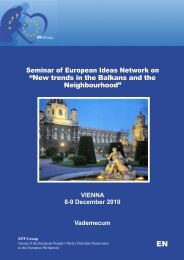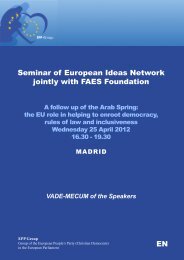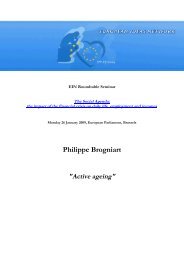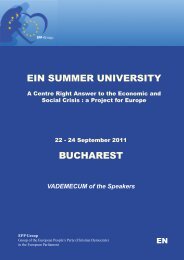TF6 Final Report - European Ideas Network
TF6 Final Report - European Ideas Network
TF6 Final Report - European Ideas Network
Create successful ePaper yourself
Turn your PDF publications into a flip-book with our unique Google optimized e-Paper software.
In summary, the issue of EU External Borders should be considered and<br />
evaluated within a framework which is based on the following essential principles:<br />
• There is a need for a strong EU, able to decide and act efficiently and to<br />
develop the integration process further towards the objective as laid down in<br />
the Treaties.<br />
• The <strong>European</strong> Union has always been more than a mere economic project. The<br />
<strong>European</strong> peoples unite and work on the basis of shared core values. This has<br />
also been clearly and unequivocally stated in Art. 6.1. TEU which forms the<br />
basis on which the EU is founded.<br />
• The main goal of the <strong>European</strong> integration process is to overcome traditional<br />
power politics based on the national interests of the <strong>European</strong> nation-states by<br />
building a new <strong>European</strong> order established on a common framework of<br />
<strong>European</strong> law; common institutions and procedures; and an independent<br />
<strong>European</strong> judiciary which would guarantee that in the future the rule of law<br />
should govern relations among member states. The purpose of the <strong>European</strong><br />
integration process is not only to create a <strong>European</strong> zone of economic welfare<br />
and strength, but to establish a stable order of peace. Its political finality is to<br />
develop an ever closer Union of the peoples of Europe.<br />
• The realisation of the <strong>European</strong> integration project demands a gradual though<br />
dynamic process of pooling partial national sovereignties and competences<br />
which are then exercised in the Union’s institutions to shape common policies<br />
in order to solve common problems and safeguard Europe’s interests on the<br />
global scene.<br />
• The EU is more than a multilateral organisation and has created a political<br />
Community which establishes interrelationships between the Member States,<br />
common institutions and the <strong>European</strong> citizens.<br />
• Its finality was already laid down in the Rome Treaties. The Treaty of<br />
Maastricht established a new quality in the integration process; the EU was<br />
established, and the building of a political Union became an agreed objective<br />
of EU Member States.<br />
• A perceived <strong>European</strong> identity and the awareness of common interests and a<br />
common fate are indispensable for the acceptance of the integration process by<br />
the <strong>European</strong> citizens. It is a precondition for their readiness to agree to the<br />
pooling of national sovereignty and national competences which in turn is<br />
indispensable for preserving and strengthening the Union’s capacity to decide<br />
and act, i.e. its problem solving capacity.<br />
• Each enlargement inescapably leads to additional internal disparities thus<br />
widening the spectrum of divergent interests and increasing internal<br />
heterogeneity. The latest enlargement has practically doubled the Union’s<br />
membership and further increased the degree of internal disparities. This<br />
underlines the urgent need to build a strong <strong>European</strong> identity, politically<br />
effective in terms of forming a firm and endurable basis for common action.<br />
8












